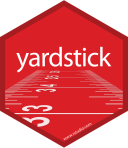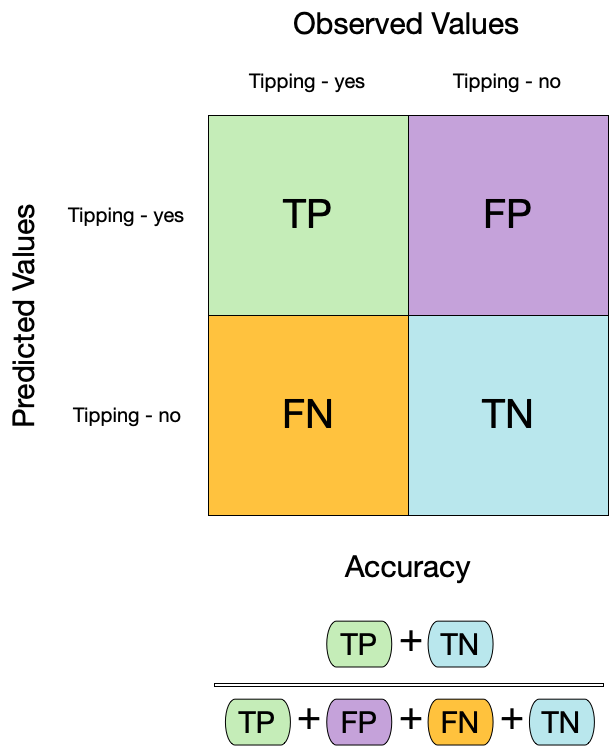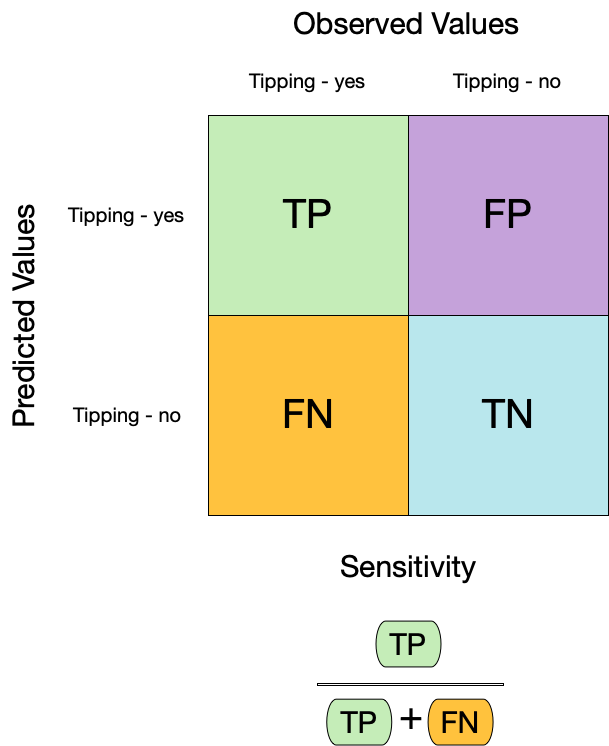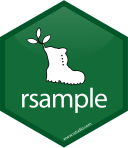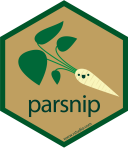augment(taxi_fit, new_data = taxi_train) %>%
relocate(tip, .pred_class, .pred_yes, .pred_no)
#> # A tibble: 8,000 × 10
#> tip .pred_class .pred_yes .pred_no distance company local dow month hour
#> <fct> <fct> <dbl> <dbl> <dbl> <fct> <fct> <fct> <fct> <int>
#> 1 yes yes 0.967 0.0333 17.2 Chicag… no Thu Feb 16
#> 2 yes yes 0.935 0.0646 0.88 City S… yes Thu Mar 8
#> 3 yes yes 0.967 0.0333 18.1 other no Mon Feb 18
#> 4 yes yes 0.949 0.0507 12.2 Chicag… no Sun Mar 21
#> 5 yes yes 0.821 0.179 0.94 Sun Ta… yes Sat Apr 23
#> 6 yes yes 0.967 0.0333 17.5 Flash … no Fri Mar 12
#> 7 yes yes 0.967 0.0333 17.7 other no Sun Jan 6
#> 8 yes yes 0.938 0.0616 1.85 Taxica… no Fri Apr 12
#> 9 yes yes 0.938 0.0616 0.53 Sun Ta… no Tue Mar 18
#> 10 yes yes 0.931 0.0694 6.65 Taxica… no Sun Apr 11
#> # ℹ 7,990 more rows4 - Evaluating models
Introduction to tidymodels
Looking at predictions
Confusion matrix ![]()

Confusion matrix ![]()
Confusion matrix ![]()
Metrics for model performance ![]()
Dangers of accuracy ![]()
We need to be careful of using accuracy() since it can give “good” performance by only predicting one way with imbalanced data
Metrics for model performance ![]()
Metrics for model performance ![]()
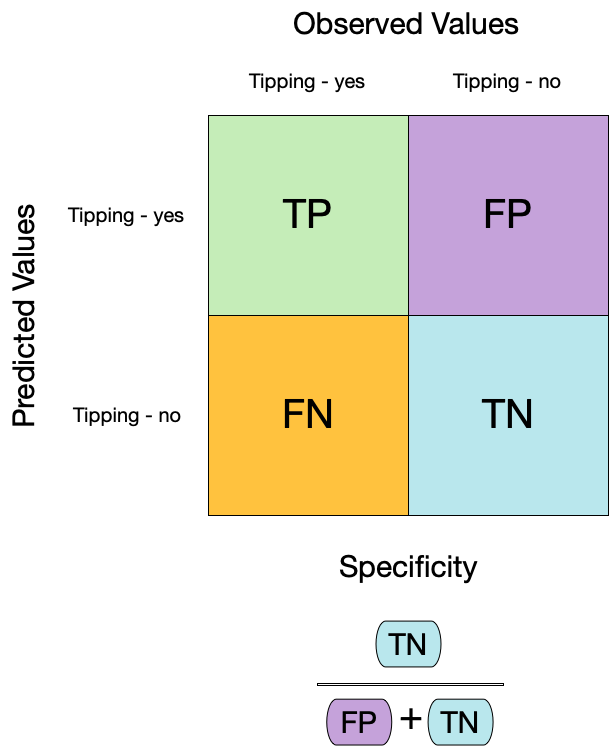
Metrics for model performance ![]()
We can use metric_set() to combine multiple calculations into one
taxi_metrics <- metric_set(accuracy, specificity, sensitivity)
augment(taxi_fit, new_data = taxi_train) %>%
taxi_metrics(truth = tip, estimate = .pred_class)
#> # A tibble: 3 × 3
#> .metric .estimator .estimate
#> <chr> <chr> <dbl>
#> 1 accuracy binary 0.928
#> 2 specificity binary 0.130
#> 3 sensitivity binary 0.994Metrics for model performance ![]()
taxi_metrics <- metric_set(accuracy, specificity, sensitivity)
augment(taxi_fit, new_data = taxi_train) %>%
group_by(local) %>%
taxi_metrics(truth = tip, estimate = .pred_class)
#> # A tibble: 6 × 4
#> local .metric .estimator .estimate
#> <fct> <chr> <chr> <dbl>
#> 1 yes accuracy binary 0.898
#> 2 no accuracy binary 0.935
#> 3 yes specificity binary 0.169
#> 4 no specificity binary 0.116
#> 5 yes sensitivity binary 0.987
#> 6 no sensitivity binary 0.996Two class data
These metrics assume that we know the threshold for converting “soft” probability predictions into “hard” class predictions.
Is a 50% threshold good?
What happens if we say that we need to be 80% sure to declare an event?
- sensitivity ⬇️, specificity ⬆️
What happens for a 20% threshold?
- sensitivity ⬆️, specificity ⬇️
Varying the threshold
ROC curves
To make an ROC (receiver operator characteristic) curve, we:
calculate the sensitivity and specificity for all possible thresholds
plot false positive rate (x-axis) versus true positive rate (y-axis)
given that sensitivity is the true positive rate, and specificity is the true negative rate. Hence 1 - specificity is the false positive rate.
We can use the area under the ROC curve as a classification metric:
- ROC AUC = 1 💯
- ROC AUC = 1/2 😢
ROC curves ![]()
# Assumes _first_ factor level is event; there are options to change that
augment(taxi_fit, new_data = taxi_train) %>%
roc_curve(truth = tip, .pred_yes) %>%
slice(1, 20, 50)
#> # A tibble: 3 × 3
#> .threshold specificity sensitivity
#> <dbl> <dbl> <dbl>
#> 1 -Inf 0 1
#> 2 0.783 0.209 0.981
#> 3 1 1 0.00135
augment(taxi_fit, new_data = taxi_train) %>%
roc_auc(truth = tip, .pred_yes)
#> # A tibble: 1 × 3
#> .metric .estimator .estimate
#> <chr> <chr> <dbl>
#> 1 roc_auc binary 0.691ROC curve plot ![]()
Your turn

Compute and plot an ROC curve for your current model.
What data are being used for this ROC curve plot?
05:00
⚠️ DANGERS OF OVERFITTING ⚠️
Dangers of overfitting ⚠️

Dangers of overfitting ⚠️

Dangers of overfitting ⚠️ ![]()
taxi_fit %>%
augment(taxi_train)
#> # A tibble: 8,000 × 10
#> tip distance company local dow month hour .pred_class .pred_yes .pred_no
#> <fct> <dbl> <fct> <fct> <fct> <fct> <int> <fct> <dbl> <dbl>
#> 1 yes 17.2 Chicag… no Thu Feb 16 yes 0.967 0.0333
#> 2 yes 0.88 City S… yes Thu Mar 8 yes 0.935 0.0646
#> 3 yes 18.1 other no Mon Feb 18 yes 0.967 0.0333
#> 4 yes 12.2 Chicag… no Sun Mar 21 yes 0.949 0.0507
#> 5 yes 0.94 Sun Ta… yes Sat Apr 23 yes 0.821 0.179
#> 6 yes 17.5 Flash … no Fri Mar 12 yes 0.967 0.0333
#> 7 yes 17.7 other no Sun Jan 6 yes 0.967 0.0333
#> 8 yes 1.85 Taxica… no Fri Apr 12 yes 0.938 0.0616
#> 9 yes 0.53 Sun Ta… no Tue Mar 18 yes 0.938 0.0616
#> 10 yes 6.65 Taxica… no Sun Apr 11 yes 0.931 0.0694
#> # ℹ 7,990 more rowsWe call this “resubstitution” or “repredicting the training set”
Dangers of overfitting ⚠️ ![]()
We call this a “resubstitution estimate”
Dangers of overfitting ⚠️ ![]()
Dangers of overfitting ⚠️ ![]()
⚠️ Remember that we’re demonstrating overfitting
⚠️ Don’t use the test set until the end of your modeling analysis
Your turn

Use augment() and a metric function to compute a classification metric like brier_class().
Compute the metrics for both training and testing data to demonstrate overfitting!
Notice the evidence of overfitting! ⚠️
05:00
Dangers of overfitting ⚠️ ![]()
What if we want to compare more models?
And/or more model configurations?
And we want to understand if these are important differences?
The testing data are precious 💎
How can we use the training data to compare and evaluate different models? 🤔
Cross-validation
Cross-validation
Your turn

If we use 10 folds, what percent of the training data
- ends up in analysis
- ends up in assessment
for each fold?
03:00
Cross-validation ![]()
vfold_cv(taxi_train) # v = 10 is default
#> # 10-fold cross-validation
#> # A tibble: 10 × 2
#> splits id
#> <list> <chr>
#> 1 <split [7200/800]> Fold01
#> 2 <split [7200/800]> Fold02
#> 3 <split [7200/800]> Fold03
#> 4 <split [7200/800]> Fold04
#> 5 <split [7200/800]> Fold05
#> 6 <split [7200/800]> Fold06
#> 7 <split [7200/800]> Fold07
#> 8 <split [7200/800]> Fold08
#> 9 <split [7200/800]> Fold09
#> 10 <split [7200/800]> Fold10Cross-validation ![]()
What is in this?
Cross-validation ![]()
Cross-validation ![]()
vfold_cv(taxi_train, strata = tip)
#> # 10-fold cross-validation using stratification
#> # A tibble: 10 × 2
#> splits id
#> <list> <chr>
#> 1 <split [7200/800]> Fold01
#> 2 <split [7200/800]> Fold02
#> 3 <split [7200/800]> Fold03
#> 4 <split [7200/800]> Fold04
#> 5 <split [7200/800]> Fold05
#> 6 <split [7200/800]> Fold06
#> 7 <split [7200/800]> Fold07
#> 8 <split [7200/800]> Fold08
#> 9 <split [7200/800]> Fold09
#> 10 <split [7200/800]> Fold10Stratification often helps, with very little downside
Cross-validation ![]()
We’ll use this setup:
set.seed(123)
taxi_folds <- vfold_cv(taxi_train, v = 10, strata = tip)
taxi_folds
#> # 10-fold cross-validation using stratification
#> # A tibble: 10 × 2
#> splits id
#> <list> <chr>
#> 1 <split [7200/800]> Fold01
#> 2 <split [7200/800]> Fold02
#> 3 <split [7200/800]> Fold03
#> 4 <split [7200/800]> Fold04
#> 5 <split [7200/800]> Fold05
#> 6 <split [7200/800]> Fold06
#> 7 <split [7200/800]> Fold07
#> 8 <split [7200/800]> Fold08
#> 9 <split [7200/800]> Fold09
#> 10 <split [7200/800]> Fold10Set the seed when creating resamples
We are equipped with metrics and resamples!
Fit our model to the resamples
taxi_res <- fit_resamples(taxi_wflow, taxi_folds)
taxi_res
#> # Resampling results
#> # 10-fold cross-validation using stratification
#> # A tibble: 10 × 4
#> splits id .metrics .notes
#> <list> <chr> <list> <list>
#> 1 <split [7200/800]> Fold01 <tibble [2 × 4]> <tibble [0 × 3]>
#> 2 <split [7200/800]> Fold02 <tibble [2 × 4]> <tibble [0 × 3]>
#> 3 <split [7200/800]> Fold03 <tibble [2 × 4]> <tibble [0 × 3]>
#> 4 <split [7200/800]> Fold04 <tibble [2 × 4]> <tibble [0 × 3]>
#> 5 <split [7200/800]> Fold05 <tibble [2 × 4]> <tibble [0 × 3]>
#> 6 <split [7200/800]> Fold06 <tibble [2 × 4]> <tibble [0 × 3]>
#> 7 <split [7200/800]> Fold07 <tibble [2 × 4]> <tibble [0 × 3]>
#> 8 <split [7200/800]> Fold08 <tibble [2 × 4]> <tibble [0 × 3]>
#> 9 <split [7200/800]> Fold09 <tibble [2 × 4]> <tibble [0 × 3]>
#> 10 <split [7200/800]> Fold10 <tibble [2 × 4]> <tibble [0 × 3]>Evaluating model performance ![]()
We can reliably measure performance using only the training data 🎉
Comparing metrics ![]()
How do the metrics from resampling compare to the metrics from training and testing?
The ROC AUC previously was
- 0.69 for the training set
- 0.64 for test set
Remember that:
⚠️ the training set gives you overly optimistic metrics
⚠️ the test set is precious
Evaluating model performance ![]()
# Save the assessment set results
ctrl_taxi <- control_resamples(save_pred = TRUE)
taxi_res <- fit_resamples(taxi_wflow, taxi_folds, control = ctrl_taxi)
taxi_res
#> # Resampling results
#> # 10-fold cross-validation using stratification
#> # A tibble: 10 × 5
#> splits id .metrics .notes .predictions
#> <list> <chr> <list> <list> <list>
#> 1 <split [7200/800]> Fold01 <tibble [2 × 4]> <tibble [0 × 3]> <tibble>
#> 2 <split [7200/800]> Fold02 <tibble [2 × 4]> <tibble [0 × 3]> <tibble>
#> 3 <split [7200/800]> Fold03 <tibble [2 × 4]> <tibble [0 × 3]> <tibble>
#> 4 <split [7200/800]> Fold04 <tibble [2 × 4]> <tibble [0 × 3]> <tibble>
#> 5 <split [7200/800]> Fold05 <tibble [2 × 4]> <tibble [0 × 3]> <tibble>
#> 6 <split [7200/800]> Fold06 <tibble [2 × 4]> <tibble [0 × 3]> <tibble>
#> 7 <split [7200/800]> Fold07 <tibble [2 × 4]> <tibble [0 × 3]> <tibble>
#> 8 <split [7200/800]> Fold08 <tibble [2 × 4]> <tibble [0 × 3]> <tibble>
#> 9 <split [7200/800]> Fold09 <tibble [2 × 4]> <tibble [0 × 3]> <tibble>
#> 10 <split [7200/800]> Fold10 <tibble [2 × 4]> <tibble [0 × 3]> <tibble>Evaluating model performance ![]()
# Save the assessment set results
taxi_preds <- collect_predictions(taxi_res)
taxi_preds
#> # A tibble: 8,000 × 7
#> id .pred_yes .pred_no .row .pred_class tip .config
#> <chr> <dbl> <dbl> <int> <fct> <fct> <chr>
#> 1 Fold01 0.938 0.0615 14 yes yes Preprocessor1_Model1
#> 2 Fold01 0.946 0.0544 19 yes yes Preprocessor1_Model1
#> 3 Fold01 0.973 0.0269 33 yes yes Preprocessor1_Model1
#> 4 Fold01 0.903 0.0971 43 yes yes Preprocessor1_Model1
#> 5 Fold01 0.973 0.0269 74 yes yes Preprocessor1_Model1
#> 6 Fold01 0.903 0.0971 103 yes yes Preprocessor1_Model1
#> 7 Fold01 0.915 0.0851 104 yes no Preprocessor1_Model1
#> 8 Fold01 0.903 0.0971 124 yes yes Preprocessor1_Model1
#> 9 Fold01 0.667 0.333 126 yes yes Preprocessor1_Model1
#> 10 Fold01 0.949 0.0510 128 yes yes Preprocessor1_Model1
#> # ℹ 7,990 more rowsEvaluating model performance ![]()
taxi_preds %>%
group_by(id) %>%
taxi_metrics(truth = tip, estimate = .pred_class)
#> # A tibble: 30 × 4
#> id .metric .estimator .estimate
#> <chr> <chr> <chr> <dbl>
#> 1 Fold01 accuracy binary 0.905
#> 2 Fold02 accuracy binary 0.925
#> 3 Fold03 accuracy binary 0.926
#> 4 Fold04 accuracy binary 0.915
#> 5 Fold05 accuracy binary 0.902
#> 6 Fold06 accuracy binary 0.912
#> 7 Fold07 accuracy binary 0.906
#> 8 Fold08 accuracy binary 0.91
#> 9 Fold09 accuracy binary 0.918
#> 10 Fold10 accuracy binary 0.931
#> # ℹ 20 more rowsWhere are the fitted models? ![]()
taxi_res
#> # Resampling results
#> # 10-fold cross-validation using stratification
#> # A tibble: 10 × 5
#> splits id .metrics .notes .predictions
#> <list> <chr> <list> <list> <list>
#> 1 <split [7200/800]> Fold01 <tibble [2 × 4]> <tibble [0 × 3]> <tibble>
#> 2 <split [7200/800]> Fold02 <tibble [2 × 4]> <tibble [0 × 3]> <tibble>
#> 3 <split [7200/800]> Fold03 <tibble [2 × 4]> <tibble [0 × 3]> <tibble>
#> 4 <split [7200/800]> Fold04 <tibble [2 × 4]> <tibble [0 × 3]> <tibble>
#> 5 <split [7200/800]> Fold05 <tibble [2 × 4]> <tibble [0 × 3]> <tibble>
#> 6 <split [7200/800]> Fold06 <tibble [2 × 4]> <tibble [0 × 3]> <tibble>
#> 7 <split [7200/800]> Fold07 <tibble [2 × 4]> <tibble [0 × 3]> <tibble>
#> 8 <split [7200/800]> Fold08 <tibble [2 × 4]> <tibble [0 × 3]> <tibble>
#> 9 <split [7200/800]> Fold09 <tibble [2 × 4]> <tibble [0 × 3]> <tibble>
#> 10 <split [7200/800]> Fold10 <tibble [2 × 4]> <tibble [0 × 3]> <tibble>🗑️
Alternate resampling schemes
Bootstrapping
Bootstrapping ![]()
set.seed(3214)
bootstraps(taxi_train)
#> # Bootstrap sampling
#> # A tibble: 25 × 2
#> splits id
#> <list> <chr>
#> 1 <split [8000/2902]> Bootstrap01
#> 2 <split [8000/2916]> Bootstrap02
#> 3 <split [8000/3004]> Bootstrap03
#> 4 <split [8000/2979]> Bootstrap04
#> 5 <split [8000/2961]> Bootstrap05
#> 6 <split [8000/2962]> Bootstrap06
#> 7 <split [8000/3026]> Bootstrap07
#> 8 <split [8000/2926]> Bootstrap08
#> 9 <split [8000/2972]> Bootstrap09
#> 10 <split [8000/2972]> Bootstrap10
#> # ℹ 15 more rowsThe whole game - status update

Your turn

Create:
- Monte Carlo Cross-Validation sets
- validation set
(use the reference guide to find the functions)
Don’t forget to set a seed when you resample!
05:00
Monte Carlo Cross-Validation ![]()
set.seed(322)
mc_cv(taxi_train, times = 10)
#> # Monte Carlo cross-validation (0.75/0.25) with 10 resamples
#> # A tibble: 10 × 2
#> splits id
#> <list> <chr>
#> 1 <split [6000/2000]> Resample01
#> 2 <split [6000/2000]> Resample02
#> 3 <split [6000/2000]> Resample03
#> 4 <split [6000/2000]> Resample04
#> 5 <split [6000/2000]> Resample05
#> 6 <split [6000/2000]> Resample06
#> 7 <split [6000/2000]> Resample07
#> 8 <split [6000/2000]> Resample08
#> 9 <split [6000/2000]> Resample09
#> 10 <split [6000/2000]> Resample10Validation set ![]()
A validation set is just another type of resample
Decision tree 🌳
Random forest 🌳🌲🌴🌵🌴🌳🌳🌴🌲🌵🌴🌲🌳🌴🌳🌵🌵🌴🌲🌲🌳🌴🌳🌴🌲🌴🌵🌴🌲🌴🌵🌲🌵🌴🌲🌳🌴🌵🌳🌴🌳
Random forest 🌳🌲🌴🌵🌳🌳🌴🌲🌵🌴🌳🌵
Ensemble many decision tree models
All the trees vote! 🗳️
Bootstrap aggregating + random predictor sampling
- Often works well without tuning hyperparameters (more on this in Advanced tidymodels!), as long as there are enough trees
Create a random forest model ![]()
Create a random forest model ![]()
rf_wflow <- workflow(tip ~ ., rf_spec)
rf_wflow
#> ══ Workflow ══════════════════════════════════════════════════════════
#> Preprocessor: Formula
#> Model: rand_forest()
#>
#> ── Preprocessor ──────────────────────────────────────────────────────
#> tip ~ .
#>
#> ── Model ─────────────────────────────────────────────────────────────
#> Random Forest Model Specification (classification)
#>
#> Main Arguments:
#> trees = 1000
#>
#> Computational engine: rangerYour turn

Use fit_resamples() and rf_wflow to:
- keep predictions
- compute metrics
08:00
Evaluating model performance ![]()
ctrl_taxi <- control_resamples(save_pred = TRUE)
# Random forest uses random numbers so set the seed first
set.seed(2)
rf_res <- fit_resamples(rf_wflow, taxi_folds, control = ctrl_taxi)
collect_metrics(rf_res)
#> # A tibble: 2 × 6
#> .metric .estimator mean n std_err .config
#> <chr> <chr> <dbl> <int> <dbl> <chr>
#> 1 accuracy binary 0.923 10 0.00317 Preprocessor1_Model1
#> 2 roc_auc binary 0.616 10 0.0147 Preprocessor1_Model1The whole game - status update

The final fit ![]()
Suppose that we are happy with our random forest model.
Let’s fit the model on the training set and verify our performance using the test set.
We’ve shown you fit() and predict() (+ augment()) but there is a shortcut:
# taxi_split has train + test info
final_fit <- last_fit(rf_wflow, taxi_split)
final_fit
#> # Resampling results
#> # Manual resampling
#> # A tibble: 1 × 6
#> splits id .metrics .notes .predictions .workflow
#> <list> <chr> <list> <list> <list> <list>
#> 1 <split [8000/2000]> train/test split <tibble> <tibble> <tibble> <workflow>What is in final_fit? ![]()
These are metrics computed with the test set
What is in final_fit? ![]()
collect_predictions(final_fit)
#> # A tibble: 2,000 × 7
#> id .pred_yes .pred_no .row .pred_class tip .config
#> <chr> <dbl> <dbl> <int> <fct> <fct> <chr>
#> 1 train/test split 0.957 0.0426 4 yes yes Preprocessor1_Mo…
#> 2 train/test split 0.938 0.0621 10 yes yes Preprocessor1_Mo…
#> 3 train/test split 0.958 0.0416 19 yes yes Preprocessor1_Mo…
#> 4 train/test split 0.894 0.106 23 yes yes Preprocessor1_Mo…
#> 5 train/test split 0.943 0.0573 28 yes yes Preprocessor1_Mo…
#> 6 train/test split 0.979 0.0213 34 yes yes Preprocessor1_Mo…
#> 7 train/test split 0.954 0.0463 35 yes yes Preprocessor1_Mo…
#> 8 train/test split 0.928 0.0722 38 yes yes Preprocessor1_Mo…
#> 9 train/test split 0.985 0.0147 40 yes yes Preprocessor1_Mo…
#> 10 train/test split 0.948 0.0523 42 yes no Preprocessor1_Mo…
#> # ℹ 1,990 more rowsWhat is in final_fit? ![]()
extract_workflow(final_fit)
#> ══ Workflow [trained] ════════════════════════════════════════════════
#> Preprocessor: Formula
#> Model: rand_forest()
#>
#> ── Preprocessor ──────────────────────────────────────────────────────
#> tip ~ .
#>
#> ── Model ─────────────────────────────────────────────────────────────
#> Ranger result
#>
#> Call:
#> ranger::ranger(x = maybe_data_frame(x), y = y, num.trees = ~1000, num.threads = 1, verbose = FALSE, seed = sample.int(10^5, 1), probability = TRUE)
#>
#> Type: Probability estimation
#> Number of trees: 1000
#> Sample size: 8000
#> Number of independent variables: 6
#> Mtry: 2
#> Target node size: 10
#> Variable importance mode: none
#> Splitrule: gini
#> OOB prediction error (Brier s.): 0.07069778Use this for prediction on new data, like for deploying
The whole game

